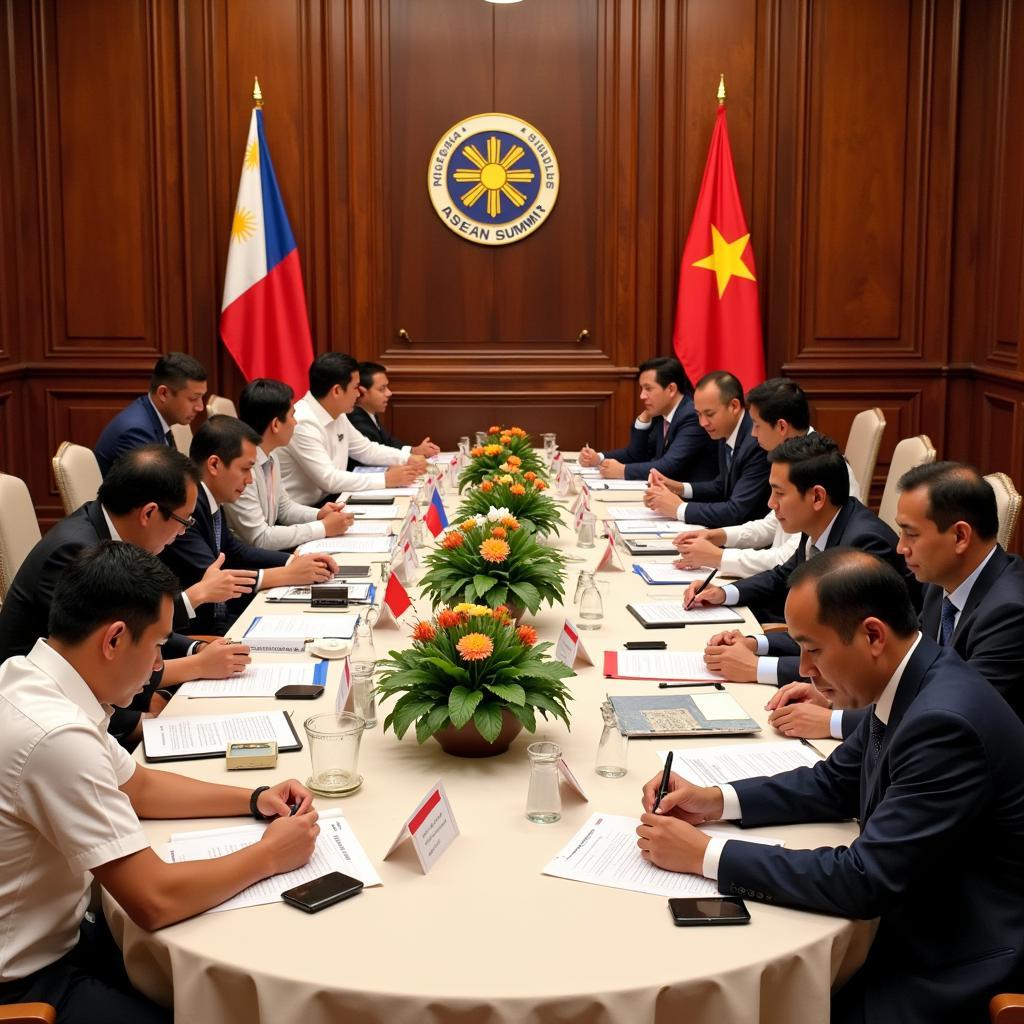Both APEC and ASEAN are prominent organizations in the Asia-Pacific region, playing crucial roles in promoting economic cooperation and regional integration. While they share some common goals, their structures, memberships, and approaches differ significantly. This article delves into a comprehensive Apec And Asean Comparison, highlighting their unique characteristics and exploring the nuances that set them apart.
 Flags of APEC and ASEAN member economies
Flags of APEC and ASEAN member economies
Understanding APEC: The Asia-Pacific Economic Cooperation
The Asia-Pacific Economic Cooperation (APEC) is a forum for 21 Pacific Rim economies that seeks to promote free trade and economic cooperation throughout the Asia-Pacific region. Established in 1989 in response to the growing interdependence of Asia-Pacific economies, APEC aims to:
- Reduce trade barriers: APEC works towards eliminating tariffs and other trade impediments among member economies.
- Facilitate investment: The forum encourages cross-border investments and promotes a favorable business environment.
- Enhance economic and technical cooperation: APEC facilitates the sharing of knowledge, expertise, and best practices among its members.
Understanding ASEAN: The Association of Southeast Asian Nations
The Association of Southeast Asian Nations (ASEAN) is a political and economic union of 10 Southeast Asian countries. Founded in 1967, ASEAN focuses on:
- Accelerating economic growth: ASEAN promotes regional economic integration and cooperation among its members.
- Promoting social progress: The organization focuses on improving the lives of people in Southeast Asia through initiatives in education, health, and social welfare.
- Safeguarding regional peace and stability: ASEAN seeks to resolve regional disputes peacefully and maintain stability within Southeast Asia.
APEC and ASEAN Comparison: Key Differences
Despite both being prominent organizations in the Asia-Pacific, APEC and ASEAN differ significantly in several aspects:
1. Geographical Scope:
- APEC: Encompasses economies across the Pacific Rim, including countries in Asia, Oceania, and the Americas.
- ASEAN: Focuses solely on Southeast Asia, with 10 member states in the region.
2. Membership:
- APEC: Consists of 21 member economies, including economic giants like the United States, China, and Japan.
- ASEAN: Comprises 10 Southeast Asian nations, with a diverse range of economic sizes and political systems.
3. Focus:
- APEC: Primarily focused on economic cooperation, trade liberalization, and investment facilitation.
- ASEAN: Addresses a broader range of issues, including political, security, and socio-cultural cooperation, alongside economic matters.
4. Structure and Decision-Making:
- APEC: Operates based on non-binding commitments and consensus-based decision-making.
- ASEAN: Characterized by a more formal institutional structure, with binding agreements and a rotating chairmanship.
 Leaders from APEC and ASEAN economies during summits
Leaders from APEC and ASEAN economies during summits
APEC and ASEAN: Exploring the Similarities
Despite the differences, APEC and ASEAN share some common ground:
- Regional Cooperation: Both organizations are committed to promoting regional cooperation, peace, and stability in the Asia-Pacific.
- Economic Integration: Both aim to enhance economic integration, though their approaches and levels of integration differ.
- Trade Liberalization: Both APEC and ASEAN advocate for free and open trade among member economies and beyond.
APEC, ASEAN, and NAFTA: A Broader Perspective
While APEC and ASEAN are often compared, it is also insightful to consider their similarities and differences with other regional organizations, such as the North American Free Trade Agreement (NAFTA). For a comprehensive analysis of these three major trade blocs, explore our dedicated article on APEC, ASEAN, and NAFTA.
Conclusion: Complementary Roles in the Asia-Pacific
APEC and ASEAN, despite their differences, play complementary roles in promoting economic growth and cooperation in the Asia-Pacific. APEC, with its broader geographical scope, fosters trans-Pacific trade and investment. ASEAN, with its focus on Southeast Asia, deepens regional integration and addresses specific regional challenges. Together, these organizations contribute significantly to the dynamic growth and development of the Asia-Pacific region.
FAQs:
-
Is a country allowed to be a member of both APEC and ASEAN?
Yes, several countries hold membership in both organizations. For example, all ASEAN member states are also members of APEC. -
Which organization holds more economic power, APEC or ASEAN?
APEC boasts significantly more economic power, as it includes economic giants like the United States, China, and Japan. However, ASEAN’s economic influence is steadily growing. -
Does APEC have a free trade agreement like ASEAN?
APEC does not have a formal free trade agreement like ASEAN. Instead, it focuses on voluntary initiatives and collaborative efforts to reduce trade barriers. -
How do APEC and ASEAN collaborate?
APEC and ASEAN engage in dialogue and cooperation on various issues, including trade facilitation, connectivity, and human capital development. -
What is the future outlook for APEC and ASEAN?
Both organizations are expected to play increasingly important roles in shaping the Asia-Pacific’s economic and political landscape. They are likely to further strengthen regional integration and cooperation in response to evolving global challenges.
Need Help?
For any queries or assistance regarding APEC, ASEAN, or any related matter, please reach out to us:
Phone: 0369020373
Email: aseanmediadirectory@gmail.com
Address: Thon Ngoc Lien, Hiep Hoa, Bac Giang, Vietnam
Our dedicated customer support team is available 24/7 to assist you.
Discover more insightful articles and resources on our website for a deeper understanding of ASEAN and the Asia-Pacific region.
